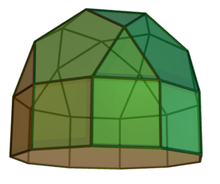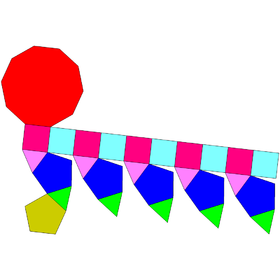Loading AI tools
From Wikipedia, the free encyclopedia
In geometry, the elongated pentagonal rotunda is one of the Johnson solids (J21). As the name suggests, it can be constructed by elongating a pentagonal rotunda (J6) by attaching a decagonal prism to its base. It can also be seen as an elongated pentagonal orthobirotunda (J42) with one pentagonal rotunda removed.
| Elongated pentagonal rotunda | |
|---|---|
 | |
| Type | Johnson J20 - J21 - J22 |
| Faces | 2x5 triangles 2x5 squares 1+5 pentagons 1 decagon |
| Edges | 55 |
| Vertices | 30 |
| Vertex configuration | 10(42.10) 10(3.42.5) 2.5(3.5.3.5) |
| Symmetry group | C5v |
| Dual polyhedron | - |
| Properties | convex |
| Net | |
 | |
A Johnson solid is one of 92 strictly convex polyhedra that is composed of regular polygon faces but are not uniform polyhedra (that is, they are not Platonic solids, Archimedean solids, prisms, or antiprisms). They were named by Norman Johnson, who first listed these polyhedra in 1966.[1]
The following formulae for volume and surface area can be used if all faces are regular, with edge length a:[2]
The dual of the elongated pentagonal rotunda has 30 faces: 10 isosceles triangles, 10 rhombi, and 10 quadrilaterals.
Seamless Wikipedia browsing. On steroids.
Every time you click a link to Wikipedia, Wiktionary or Wikiquote in your browser's search results, it will show the modern Wikiwand interface.
Wikiwand extension is a five stars, simple, with minimum permission required to keep your browsing private, safe and transparent.